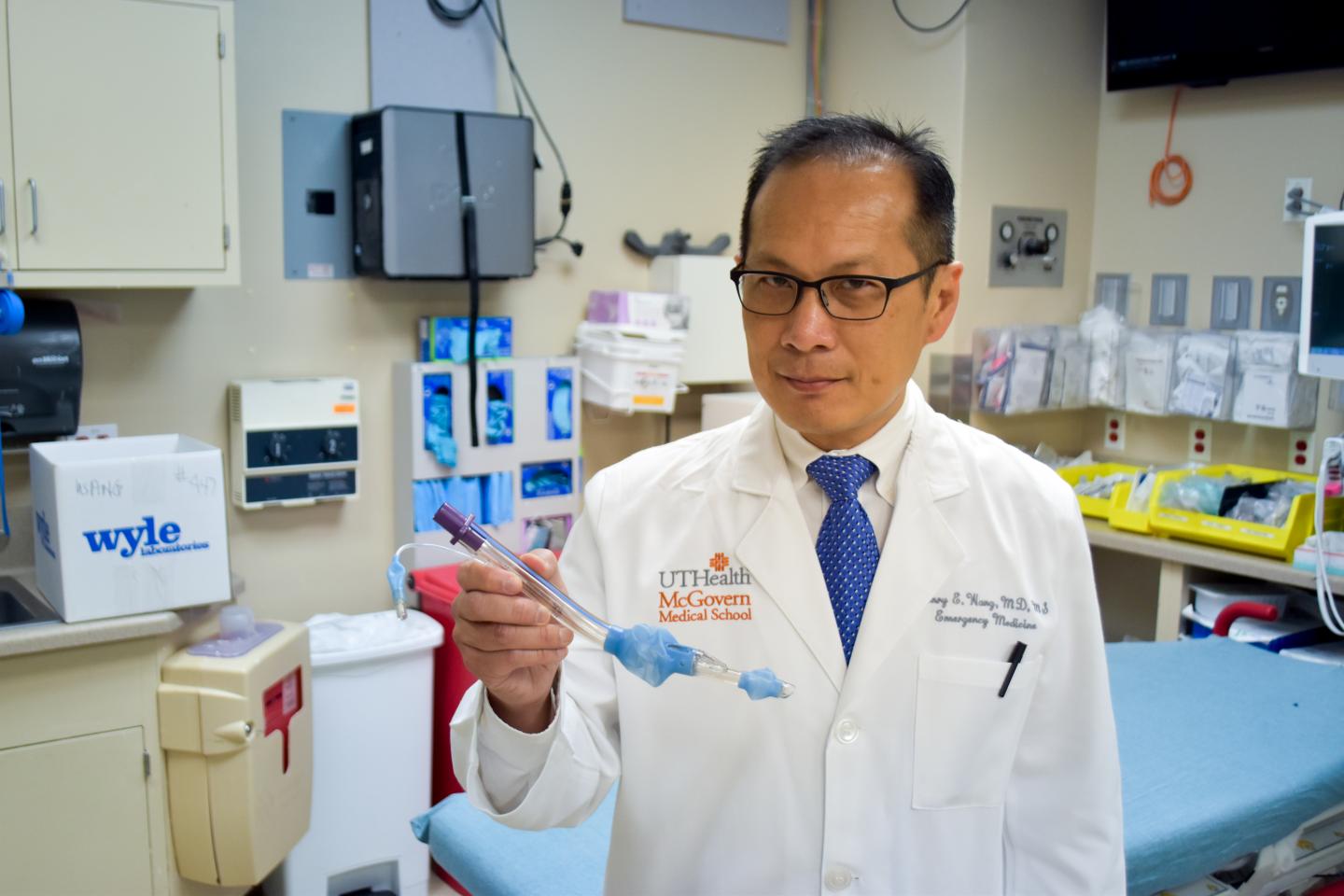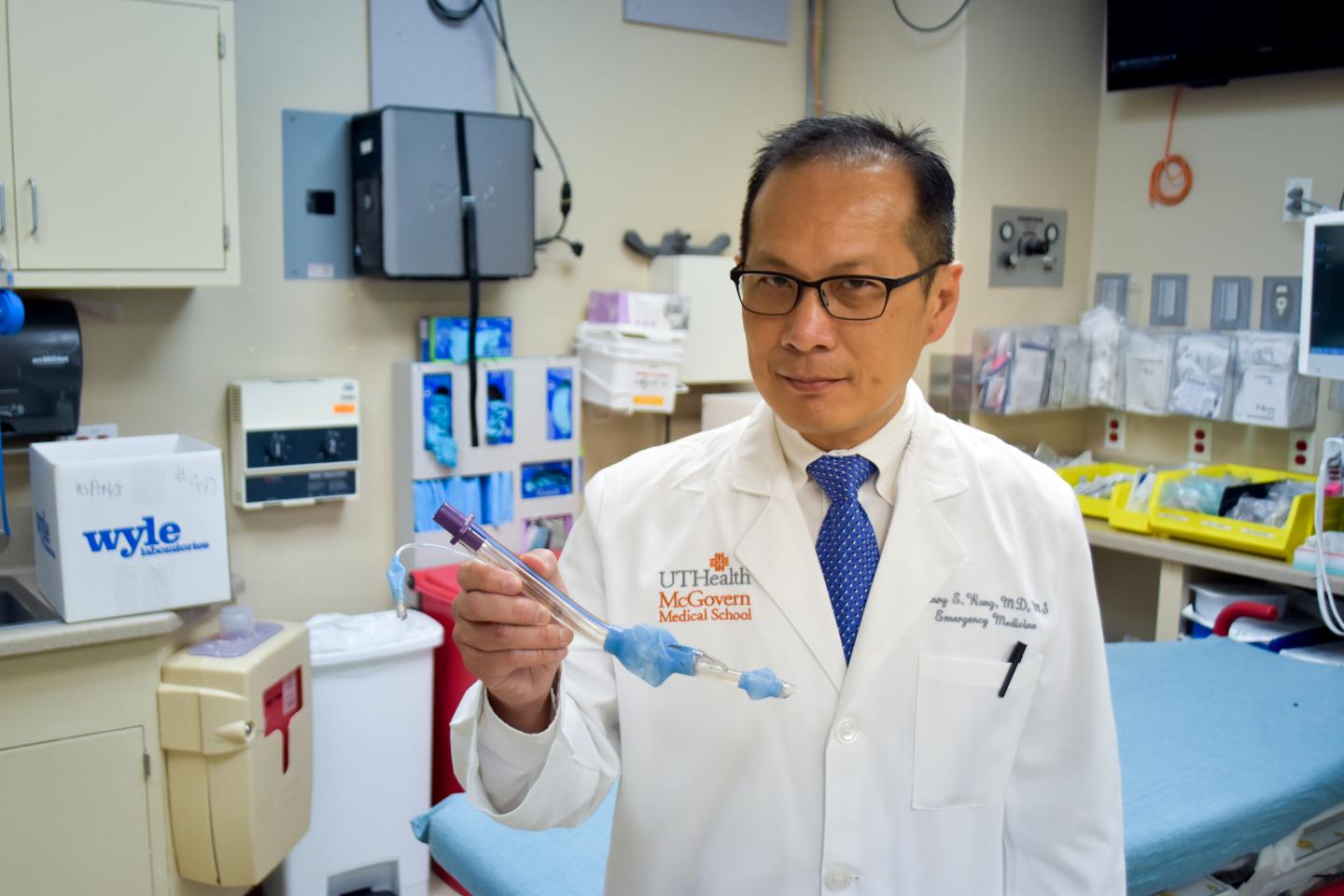
Credit: Courtesy of Rob Cahill, UTHealth.
A new study showed that a change in the type of breathing tube paramedics use to resuscitate patients with sudden cardiac arrest can significantly improve the odds of survival and save thousands of lives. More than 90 percent of Americans who experience sudden cardiac arrest die before, or soon after, reaching a hospital.
"During resuscitation, opening the airway and having proper access to it is a key factor for the survival of someone who goes into cardiac arrest outside of a hospital," said George Sopko, M.D., M.P.H., program director in the NHLBI's Division of Cardiovascular Sciences and coauthor of the study. "But one of the burning questions in prehospital emergency care has been, 'Which is the best airway device?'"
Funded by the National Heart, Lung, and Blood Institute (NHLBI), part of the National Institutes of Health, this study is the largest of its kind to test oxygen delivery methods used by firefighters, emergency medical service (EMS) providers and paramedics. It is the first to show that a particular airway intervention can positively affect patient survival rates. The findings were published online in the Journal of the American Medical Association.
"This study demonstrated that just by managing the airway well in the early stage of resuscitation, we could save more than 10,000 lives every year," said Sopko.
EMS providers treat the majority of the 400,000 out-of-hospital cardiac arrests each year. For more than three decades, their standard-of-care technique for resuscitation has been endotracheal intubation — the insertion of a plastic tube into the trachea to maintain an open airway. They use this technique in hopes that mirroring the care given by in-hospital physicians will produce better patient outcomes.
"While identical to techniques used by doctors in the hospital, intubation in these severe and stressful prehospital settings is very difficult and fraught with errors," said Henry E. Wang, M.D., professor and vice chair for research in the Department of Emergency Medicine at McGovern Medical School at The University of Texas Health Science Center at Houston. Wang was the study's lead author.
Today, however, new devices such as laryngeal tubes, offer simpler alternatives to opening and accessing an airway. These tubes are easier to use, and the trial showed that cardiac arrest patients treated with this alternative had a higher survival rate.
Usually caused by a heart attack, sudden cardiac arrest occurs when the heart suddenly or unexpectedly stops beating, cutting off blood flow to the brain and other vital organs. The vast majority of out-of-hospital cardiac arrests occur at home, and only about 10 percent of people survive, according to the American Heart Association.
The Pragmatic Airway Resuscitation Trial was a multicenter research study conducted by the Resuscitation Outcomes Consortium. It compared survival rates among 3,000 adults with cardiac arrest who were treated by paramedic crews from 27 EMS agencies, in Birmingham, Alabama; Dallas-Fort Worth; Milwaukee; Pittsburgh; and Portland, Oregon. Approximately half of the patients received the newer laryngeal tube treatment, while the other half received traditional endotracheal intubation.
Overall, patients in the laryngeal tube group had significantly better outcomes. For instance, 18.3 percent of patients survived three days in the hospital and 10.8 percent survived to reach hospital discharge. For the group with traditional endotracheal intubation, the survival numbers were 15.4 and 8.1 percent, respectively. Also, the proportion of patients surviving with good brain function was higher in the laryngeal tube group.
###
Study
H.E. Wang et al. Effect of a Strategy of Initial Laryngeal Tube Insertion vs. Endotracheal Intubation on 72-Hour Survival in Adults with Out-of-Hospital Cardiac Arrest: A Randomized Clinical Trial. Journal of the American Medical Association. August 28, 2018. DOI: 10.1001/jama.2018.7044
Part of the National Institutes of Health, the National Heart, Lung, and Blood Institute (NHLBI) plans, conducts, and supports research related to the causes, prevention, diagnosis, and treatment of heart, blood vessel, lung, and blood diseases; and sleep disorders. The Institute also administers national health education campaigns on women and heart disease, healthy weight for children, and other topics. NHLBI press releases and other materials are available online at http://www.nhlbi.nih.gov.
About the National Institutes of Health (NIH): NIH, the nation's medical research agency, includes 27 Institutes and Centers and is a component of the U.S. Department of Health and Human Services. NIH is the primary federal agency conducting and supporting basic, clinical, and translational medical research, and is investigating the causes, treatments, and cures for both common and rare diseases. For more information about NIH and its programs, visit http://www.nih.gov.
NIH…Turning Discovery Into Health
Media Contact
NHLBI Engagement and Media Relations Branch
[email protected]
301-496-5449
http://www.nhlbi.nih.gov





